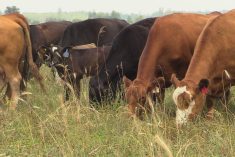Chicago | Reuters — Cattle placed into U.S. feedlots in December slipped one per cent from a year earlier to their lowest level since 1998, based on a U.S. Department of Agriculture report Friday, but were slightly above average industry expectations.
Feedlots finally purchased less-expensive calves, or feeder cattle, that had grown heavier on healthy grazing pastures for several months, said analysts.
And, December 2015’s placement outcome appeared larger when compared with December 2014’s placements when fewer animals were available as the industry continued to recover from severe drought in 2012.
Read Also

Nutrien tops profit estimates, launches review of phosphate business
Nutrien beat analysts’ expectations for third-quarter profit on Wednesday, and said it would initiate a review of strategic alternatives for its phosphate business.
Cattle that entered feedlots in November will arrive at packing plants around late spring, the analysts said.
Friday’s USDA report showed December placements at 1.525 million head, down one per cent from 1.537 million in December 2014, but above analysts’ average forecast of 1.469 million.
USDA put the feedlot cattle supply as of Jan. 1 at 10.573 million head, nearly in line with 10.626 million a year ago. Analysts, on average, had forecast a drop of one per cent.
The government said the number of cattle sold to packers, or marketings, rose one per cent in December from a year ago, to 1.674 million head.
Analysts projected a 1.9 per cent increase from 1.655 million last year.
“The shock, placement-wise, is that there was such huge closeout losses that people didn’t think that cattle feeders were going to replace these cattle, but they did,” said Allendale Inc. president Paul Georgy.
He pointed out that December placements fell to their lowest for the month since 1998.
Feedyards last month, on average, lost US$473 per head of cattle sold to meat companies, their 13th straight month of losses, as calculated by the Colorado-based Livestock Marketing Information Center (LMIC).
With the exception of more cattle placed in December than expected, the data generally was close to average trade forecasts, said LMIC economist Jessica Sampson.
She attributed last month’s placement slowdown in part to the decline in prices for feeder cattle that may have helped feedlots offset lower prices paid by packers for supplies.
“Feedlots were losing money, but they still needed those live animals,” said Sampson.
Analysts viewed USDA data as neutral to moderately bearish for Chicago Mercantile Exchange live cattle futures on Monday.
Prices for Friday’s market-ready, or cash, cattle and beef at wholesale, along with U.S. stock market direction, will influence futures more than USDA’s report, they said.
— Theopolis Waters reports on livestock markets for Reuters from Chicago.















